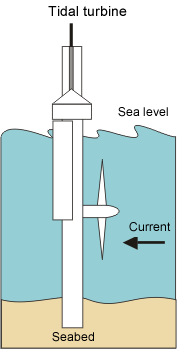The gravitational pull of the moon and sun along with the rotation of the earth cause the tides. In some places, tides cause water levels near the shore to vary up to 40 feet. People in Europe harnessed this movement of water to operate grain mills more than a 1,000 years ago. Today, tidal energy systems generate electricity. Producing tidal energy economically requires a tidal range of at least 10 feet.

Source: Stock photography (copyrighted)
Tidal barrages
One type of tidal energy system uses a structure similar to a dam called a barrage. The barrage is installed across an inlet of an ocean bay or lagoon that forms a tidal basin. Sluice gates on the barrage control water levels and flow rates to allow the tidal basin to fill on the incoming high tides and to empty through an electricity turbine system on the outgoing ebb tide. A two-way tidal power system generates electricity from both the incoming and outgoing tides.
A potential disadvantage of tidal power is the effect a tidal station can have on plants and animals in estuaries of the tidal basin. Tidal barrages can change the tidal level in the basin and increase turbidity (the amount of matter in suspension in the water). They can also affect navigation and recreation.
Several tidal power barrages operate around the world. The Sihwa Lake Tidal Power Station in South Korea has the largest electricity generation capacity at 254 Megawatts (MW). The oldest and second-largest operating tidal power plant is in La Rance, France, with 240 MW of electricity generation capacity. The next largest tidal power plant is in Annapolis Royal in Nova Scotia, Canada, with 20 MW of electricity generation capacity. China, Russia, and South Korea all have smaller tidal power plants.

Source: Adapted from National Energy Education Development Project (public domain)
The United States does not have any tidal power plants, and it only has a few sites where tidal energy could be economical to produce. France, England, Canada, and Russia have much more potential to use tidal power.
Tidal turbines
Tidal turbines look similar to wind turbines. They can be placed on the sea floor where there is strong tidal flow. Because water is about 800 times denser than air, tidal turbines have to be much sturdier and heavier than wind turbines. Tidal turbines are more expensive to build than wind turbines but capture more energy with the same size blades. The tidal turbine projects in Scotland and South Korea have tidal turbines with 1.5 MW electricity generation capacity. The project in Scotland is planning to have up to 400 MW of electricity generation capacity. A demonstration tidal turbine project is under development in the East River of New York.
Tidal fences
A tidal fence is a type of tidal power system that has vertical axis turbines mounted in a fence or row placed on the sea bed, similar to tidal turbines. Water passing through the turbines generates electricity. As of the end of 2017, no tidal fence projects were operating.



